Viewed 6926 times | words: 6158
Published on 2022-12-12 21:00:00 | words: 6158
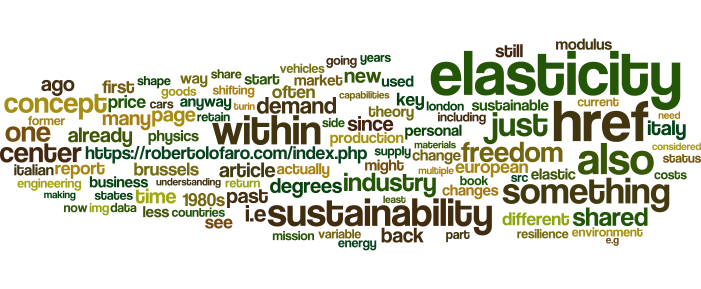
This article has been in stand-by for more than a week- waiting to see some further data.
As you know, in 2020 decided to spend the lockdown to do what I had procrastinated for a while- as would have required at least one-two months to kick-start, and then years to generate "traction", i.e. updating on my "data" side.
Now, despite the apparent zig-zag, all the courses that I followed since 2017, including those while on a mission (2015-2018), trying to build again my consulting activity in Italy (2018- when I saw that there was demand, but unpaid). and during a further missions (2021-2022), are within the same scope.
Or: which domain would not directly compete with activities that I have been officially allowed since 2012, when I had to return from Brussels, while using such a domain to see what to retain or remove of my past activities (see CV online for a sample), cross-industry, and cross-domain?
Sustainability and its impact- keeping in line with the motto that I had selected for my Linkedin profile: "change, with and without technology".
Why? Because many still consider "sustainability" as a technical issue, but in reality it is a cultural and organizational structural change, where of course a data-driven attitude might help to follow a gazillion of threads, but the "human side" should not be forgotten.
And, anyway, whatever industry you are in, sustainability has multiple dimensions.
The toolset that updated and built is actually structured also for other uses, including the industries I worked in (e.g. will keep releasing on the "organizational support" section new application/initiative proposals, and, when I will have time, the associated feasibility studies or other material useful for implementation).
I will give a short personal example of "systemic sustainability".
My background has been, as I wrote in the past, across domains, cultures, etc.
And, while both in London and Brussels (where I planned to settle in my previous two resettlement abroad), was integrating in the territory, frankly, as my return to Italy in 2012 was not a choice, as I shared in November 2011 with a friend in Paris, first I wanted to look if it was feasible settling.
An American friend told me once in London before a business meeting that was presented as a tremendous business opportunity to support a startup, but from the "signal intelligence" was highly skeptical... "you will not be disappointed".
As I wrote in the past- genius loci, that also other foreigners I met in Turin since 2012 noticed (one said it was Stasi-like).
Let's say that for personal reasons in 2016 turned down an offer to return abroad and leave the mission that I had started in August 2015 and kept until February 2018, while in July 2021, past the various COVID restrictions, selected a mission in Italy over a mission abroad, only because the mission was complementary to other I had had, and was potentially enabling settling.
Well, to summarize my experience in Turin since 2012: it was actually akin to 1989, when I resigned from my first employment, and on the exit interview... was offered a chance to have in two years potentially... a role much lower than the one that I was acknowledged by others and was delivering, and lower than the one that I eventually signed up for.
The curious part: if I had stayed since the 1980s in Turin, I would have never developed the experiences and skills that had developed on-the-job elsewhere in Italy and abroad, often either with my own or somebody else's investment and risk-taking.
A pigeonholing socio-economy system is inclined toward extracting value from investments, or at most brownfield investments, not greenfield ones.
As shown also by other local companies that, to grow, either moved elsewhere, or transferred ownership abroad.
It is not a universal truth, of course- as there are others smaller that thrived by structurally embedding within the territory.
How it is relevant? Because it is an example of systemic (i.e. structural) issues.
And how it is multidimensional: sustainability does not necessarily implies "for all"- but, as you do not know what the future will demand, in a data-centric society it makes more sense to spread instead of concentrating, if you do not want to be the next Kodak.
Otherwise, when you will need it most, you will not have access to the "human capital" (and maybe also risk capital) needed.
Citizens usually look at the physical environment, but private and public organizations are gradually considering the impacts of a systemic concept of sustainability as covering not just natural resources, or our consumption thereof, but also how will we transition, and the integration within the social ecosystem.
As my first official business project in 1986 was in automotive in Turin, will use an example of systemic concepts this industry.
Shared in the past a book review on "silicon Germany", that already in 2017 discussed the potential impacts of digital transformation across multiple industries and society at large.
In automotive, it is not just a matter of using fossil fuels vs. electricity or hydrogen or something else, and the obvious associated impacts on those producing components or providing services for the "old engines".
It is also a matter of shifting from a market used to mass-production and continuous replacement of vehicles every few years (including courtesy of the "planned obsolescence" embedded e.g. within the regulatory side), to a market that, in order to use as much as possible vehicles close to 100% (instead of the 10-20% most used to report), will have to shift.
Or: from a mass-consumption vehicle that, being used less, would need a different concept of durability and maintenance, to vehicles used as a capital investment, with higher durability, less or anyway predictive/programmed maintenance that reduces downtime, and less tolerance for, say, a three days stay of a vehicle in a repair shop.
How many new vehicles will the market absorb in, say, 2030? According to a report from 2020, presenting the opportunities for investment within the Italian automotive industry, in 2018 the global market "According to the Italian National Automobile Industry Association (ANFIA), the global production of motor vehicles was approximately 95.9 million units in 2018, a year-on-year decrease of 0.8%."
More recently, from Audi was uttered that there is a 50/50 chance that the company will not be there in a decade.
Shifting from a retail consumption of cars and provision of associated services, to a mediated pay-per-use would also make sense to better manage e.g. the use of electric cars as "batteries" for the distribution network.
The second industry I worked on, from 1987, was banking.
Being based on virtual assets, with an already shrinking basis of physical presence, the banking industry has already been shifting model, but as was described in Womack's book "The Machine That Changed The World", we really reshaped during the XX century our society (at least in industrialized countries) around not just production, but also consumption (and service) patterns required to make that industry economically (and socially) sustainable.
But both industries still need to evolve in terms of mindset and approach.
If your concept of automotive is associated with private ownership of your vehicles and at most a glasshour substitution model (i.e. the top changes more frequently, the bottom less), you are probably looking in the wrong direction.
Ditto for banking if you keep looking retail as if customer acquisition were as in the past, when most customers would not bother to switch- the 1990s universal bank that tries to sell now everything using generic approaches is a "push" model still based on mass consumption, while data would allow to do something else, and the new breed of customers probably will look toward something closer to the 2020s mobile data and voice service: a commodity.
And also in automotive or other vehicles, if you shift toward a pay-per-use, you are selling a commodity.
It is a matter of perception that generates a feed-back loop, a kind of "self-fulfilling prophecy", i.e. perception drives choices that, in turn, drive perceptions.
The risk is always that a sum of perceptions replaces the observation of reality and, instead, generate a new reality.
Today released on Kaggle a dataset extracted from the 2022 Global Risk Report published by WEF.
And the risks include also the potential impact on critical industries.
While the commentary within the WEF report is interesting, I focused on an appendix, to extract data about the risk prioritization perception across the EU 27:
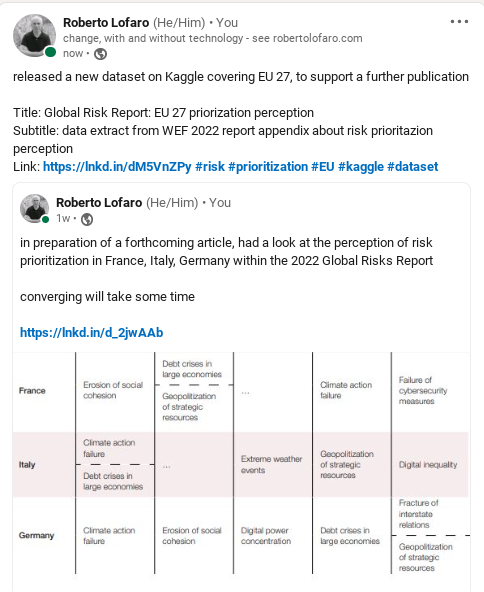
There are some who, unwillingly echoing Luddites of centuries ago, would like to "freeze" reality.
But the point, as the title of this article says, is about the governance.
I was going to make the usual promise (to keep this article short), but instead decided that should not foster a false hope.
Instead, I can share that this time will reverse my customary habit of starting with some lessons from my past experiences, and then going on with generalizations.
I know that this will surprise some who saw the first draft of this article, but anyway will add a further twist (that actually tested few articles ago): will start with few suggested readings.
When it comes to sustainability, nowadays you can get into any bookshop anywhere within the European Union, and you will find dozen of books.
But when it comes to elasticity, generally the first suggestion your will get is to look at the economics section, while some may talk about engineering or physics.
If you read previous articles, you know a bit about my activities within the "data" domain since the 1980s, something that, just in case, summarized again ten days ago on Linkedin:
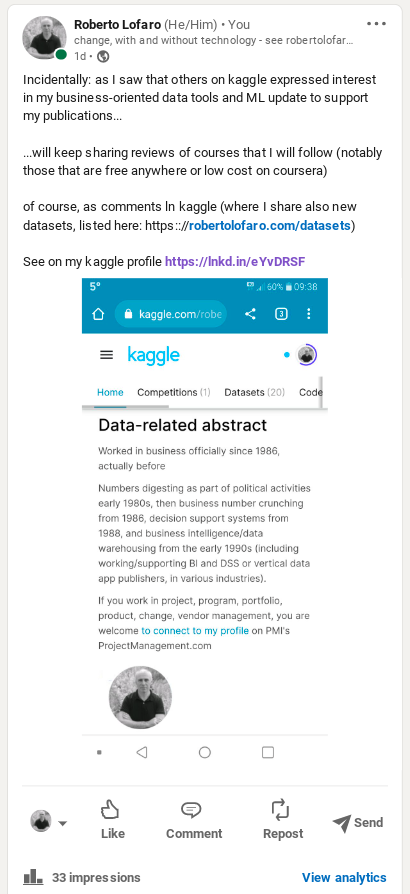
This article, and its title, were actually inspired by another side of my business experience since the 1980s.
But more about this later, when I will shift again to examples from my experience.
Here are the sections:
_readings and sampling definitions
_everywhere and nowhere
_it takes more and less
_going systemic
The first step? To have a shared framework of reference.
Readings and sampling definitions
Let's start with the suggested readings for this article (links to my short review, posted few years ago), to share a common framework:
_Rawls, John "A Theory of Justice: Original Edition" (yes, a 1970s book)
_Schmitt, Carl "La Notion De Politique/Theorie Du Partisan (French Edition)" (a 1930s and a 1960s book)
_Stewart, Col. Bob "Leadership under Pressure: Tactics from the Frontline" (interesting the part on crisis management)
_Axelrod, Robert M. "The evolution of cooperation" (interesting the concepts around the consequences of attrition on shifting from competition to collusion by consensus)
_Roth, Alvin E. "Who Gets What ? and Why: The New Economics of Matchmaking and Market Design" (and associated concepts, if you think of a market as an ecosystem that has to be sustainable to survive and evolve)
_Putnam, Robert D. "Making democracy work : civic traditions in modern Italy"
_Manin, Bernard "Principes du gouvernement représentatif" (interesting for the design of trust-based organizations)
How do these books connect with the title?
Sustainability is presented often as an absolute- but what is considered acceptable or not, socially sustainable or not, is really a social construct.
For the sake of simplicity, it is anyway worth sharing some excerpts from (potential) common definitions.
Elasticity and prices
"The degree to which changes in price translate into changes in demand and supply is known as the product's price elasticity. Demand for basic necessities is relatively inelastic, meaning it is less responsive to changes in their price."
Sustainability as a conceptual standard
"Brundtland Commission. In the commission's 1987 report, titled Our Common Future (also known as the Brundtland Report), sustainable development is defined as development that "meets the needs of the present without compromising the ability of future generations to meet their own needs."
Elasticity within physics
"In physics and materials science, elasticity is the ability of a body to resist a distorting influence and to return to its original size and shape when that influence or force is removed. Solid objects will deform when adequate loads are applied to them; if the material is elastic, the object will return to its initial shape and size after removal. This is in contrast to plasticity, in which the object fails to do so and instead remains in its deformed state.
The physical reasons for elastic behavior can be quite different for different materials. In metals, the atomic lattice changes size and shape when forces are applied (energy is added to the system). When forces are removed, the lattice goes back to the original lower energy state. For rubbers and other polymers, elasticity is caused by the stretching of polymer chains when forces are applied.
Hooke's law states that the force required to deform elastic objects should be directly proportional to the distance of deformation, regardless of how large that distance becomes. This is known as perfect elasticity, in which a given object will return to its original shape no matter how strongly it is deformed. This is an ideal concept only; most materials which possess elasticity in practice remain purely elastic only up to very small deformations, after which plastic (permanent) deformation occurs.
In engineering, the elasticity of a material is quantified by the elastic modulus such as the Young's modulus, bulk modulus or shear modulus which measure the amount of stress needed to achieve a unit of strain; a higher modulus indicates that the material is harder to deform. The SI unit of this modulus is the pascal (Pa). The material's elastic limit or yield strength is the maximum stress that can arise before the onset of plastic deformation. Its SI unit is also the pascal (Pa)."
Elasticity in economics
"Elasticity is an important concept in neoclassical economic theory, and enables in the understanding of various economic concepts, such as the incidence of indirect taxation, marginal concepts relating to the theory of the firm, distribution of wealth, and different types of goods relating to the theory of consumer choice. An understanding of elasticity is also important when discussing welfare distribution, in particular consumer surplus, producer surplus, or government surplus.
Elasticity is present throughout many economic theories, with the concept of elasticity appearing in several main indicators. These include price elasticity of demand, price elasticity of supply, income elasticity of demand, elasticity of substitution between factors of production, cross-price elasticity of demand, and elasticity of intertemporal substitution.
In differential calculus, elasticity is a tool for measuring the responsiveness of one variable to changes in another causative variable. Elasticity can be quantified as the ratio of the percentage change in one variable to the percentage change in another variable when the latter variable has a causal influence on the former and all other conditions remain the same. For example, the factors that determine consumers' choice of goods mentioned in consumer theory include the price of the goods, the consumer's disposable budget for such goods, and the substitutes of the goods."
Degrees of freedom in physics
"In physics, the degrees of freedom (DOF) of a mechanical system is the number of independent parameters that define its configuration or state. It is important in the analysis of systems of bodies in mechanical engineering, structural engineering, aerospace engineering, robotics, and other fields.
The position of a single railcar (engine) moving along a track has one degree of freedom because the position of the car is defined by the distance along the track. A train of rigid cars connected by hinges to an engine still has only one degree of freedom because the positions of the cars behind the engine are constrained by the shape of the track.
An automobile with highly stiff suspension can be considered to be a rigid body traveling on a plane (a flat, two-dimensional space). This body has three independent degrees of freedom consisting of two components of translation and one angle of rotation. Skidding or drifting is a good example of an automobile's three independent degrees of freedom.
The position and orientation of a rigid body in space is defined by three components of translation and three components of rotation, which means that it has six degrees of freedom.
The exact constraint mechanical design method manages the degrees of freedom to neither underconstrain nor overconstrain a device."
If, anyway, you accept my concept that sustainability is a social construct, then, in the end, it is a convergence of political choices.
We would like to assume that there is just one concept of sustainability, that it is a yes-no choice, but, in reality, if we found the need to define target dates, such as 2030 (for the SDGs) and 2050 (the EU Climate targets), it means that we need a shared external target to formalize a consensus, not that we have a consensus on what sustainability means.
When we turn political consensus into acceptance of what is "sustainable", we have to balance costs and benefits.
A long-term concept of sustainability might require to generate current costs and negative externalities, for benefits that probably will potentially materialize well after many of those accepting the costs will be gone.
A short-term concept of sustainability would certainly satisfy many current voters more than the previous alternative, but of course would not be a concept of sustainability acceptable to those who, one hundred years from now, might find themselves paying the consequences.
Hence, we talk talk about "sustainability", but our ability to adapt, our "elasticity", might require considering what are our real degrees of freedom in making choices, i.e. what would be the systemic impact.
Shifting from theory to practice, would like now to those a couple of sections discussing a personal perspective on what "adapating" might imply.
Everywhere and nowhere
As I shared ten days ago:
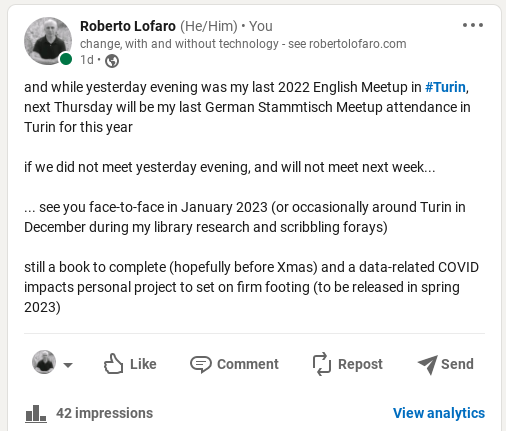
Specifically, a couple of interactions at that last English language event.
Let's start from the last interaction: was asked few times how did I cope with my old business approach (1990s-2000s) of working by mission and in multiple locations, countries, languages, as I was each time meeting new people.
I gave a boilerplate reply, but shared a bit more occasionally in segments in various encounters in other events in Turin or at morning coffee breaks.
Frankly, whenever I am asked these questions, it sounds to me a misunderstanding: I was temporarily there, not settling there.
Hence, the point was not to build office or location friendships (albeit I am still in touch with former customers or former classmates also from missions or training courses between the 1990s and 2010s).
The key element, in my case, was that in each mission that was concurrent and spread across time I was helped by my memory skills that were developed as a kid, son of an actor, a kid who helped to rehearse script lines and... ended up needing only a couple of rehearsals to remember (temporarily) the script "incoming and outgoing" lines (i.e. those before and those after my father's line).
After decades without using that skill, I discovered that it was still alive when a former girlfriend in Rome asked me to help her rehearse her lines.
Then, I usually say that I forget everything after it is not needed anymore- but it is not really true.
My "connecting the dots" across multiple domains, or resurrecting with minimal focused time "packages of knowledge", required to retain something.
So, each "section" of each mission (both for onsite and remote interactions) were based on remembering what was needed at the time, connected somehow ("embedding" is contextual, in my case) with something that sounded relevant to those I interacted with, that acted as a "key" to continue discussions or recollect later on.
And, often, those "keys" were relational, i.e. personal or results of personal interactions of those I interacted with with their own environment, neither necessarily "data-based" nor "strictly business".
Once a mission is done? I do not really forget, I simply "shift back" gradually, until only some key elements of the experience (yes, "lessons learned" or "what could have been done in a different way") are available on demand.
But it is not a one-way street: I did remember even after a decade the "keys", but apparently also those involved did.
Other key elements?
Something that "connects the dots"- ranging from returning in the same environment, meeting again the same people, or doing something completely new but that somehow has patterns that could be complemented, augmented, completed, or just obtain value added by prior patterns developed elsewhere.
Let me summarize it in another way: my personal approach to being everywhere and nowhere (as some said back then, it felt as if they met me for social events more often than locals) is...
...to listen, keep listening more than talking (if feasible), and continue converging toward "embedding", i.e. adopting contextual speech patterns, including lingo and cultural references.
In past articles, I shared jokes on how, unwillingly, often that extended to switching accents.
It takes more and less
I have been called Canadian and Argentinian in Paris, Swiss German elsewhere, in London a bus conductor said that I had an American-Japanese accent, and once in Texas was told something even more exotic.
Right now? Of course, having been since 2012 mainly in Piedmon, absolutely an Italian accent in any language (but stay tuned).
Next? It depends.
This long digression-within-a-digression is just to say that you have to have a mix of "mechanics" and "instincts".
The latter might by a mix of "natural" (yes, I have been called also that, in London) and "built up", but, frankly, I met enough psychopaths with fake empathy in my business and personal peregrinations.
And there is something else: understanding the context.
The question about how do I cope in a new environment with new people on such a frequent basis, was also reminding me something that anybody who worked with me anywhere eventually hears me uttering.
Or: contextualization it is always also a matter of degrees of freedom and "weak links", i.e. understanding what would be feasible in the specific context, not because of you, but because of the mix.
My boilerplate answer had shifted from a generic "how do you cope in a new environment" to the specific context where we were (a meetup) and similar environments (e.g. language exchange or conversation groups).
Be in London, Zurich, Brussels, Frankfurt, if I joined (temporarily) a group, beside a quick introduction, I listened and then joined conversations, but anywhere I went I always found somebody who followed a different pattern.
Generally, in each group started by sharing the same "canned" speech, or preparing for each meeting a "canned" subject to talk about.
In Turin, since 2012 happened to me more often than usual, on various subjects- courtesy of my CV.
The first interaction at the English language was about the ongoing energy costs crisis, on the tune of "supply and demand", or, rather "demand and offer" by setting price etc.
To make a long story short: I replied with the obvious objections: talking about basic needs of individuals and families is not akin to talking about companies, then added that elasticity must be considered, as otherwise the risk is social unrest.
So, it takes more and less, to identify the sustainability across time: short-term (say- this winter), medium-term (say, until 2026), long-term (say, beyond 2026).
Why 2026?
A quote from the website about the Recovery and Resilience Facility, part of the measures generally identified with the NextGenerationEU: " The RRF entered into force on 19 February 2021. It finances reforms and investments in Member States from the start of the pandemic in February 2020 until 31 December 2026. To finance NextGenerationEU, the European Commission, on behalf of the EU, will borrow on the capital markets.
To benefit from the support of the Facility, Member States submit their recovery and resilience plans to the European Commission. Each plan sets out the reforms and investments to be implemented by end-2026 and Member States can receive financing up to a previously agreed allocation. ".
This is the current status of what happens when actions are carried top-down, instead of going systemic, i.e. ensuring the operational feasibility:
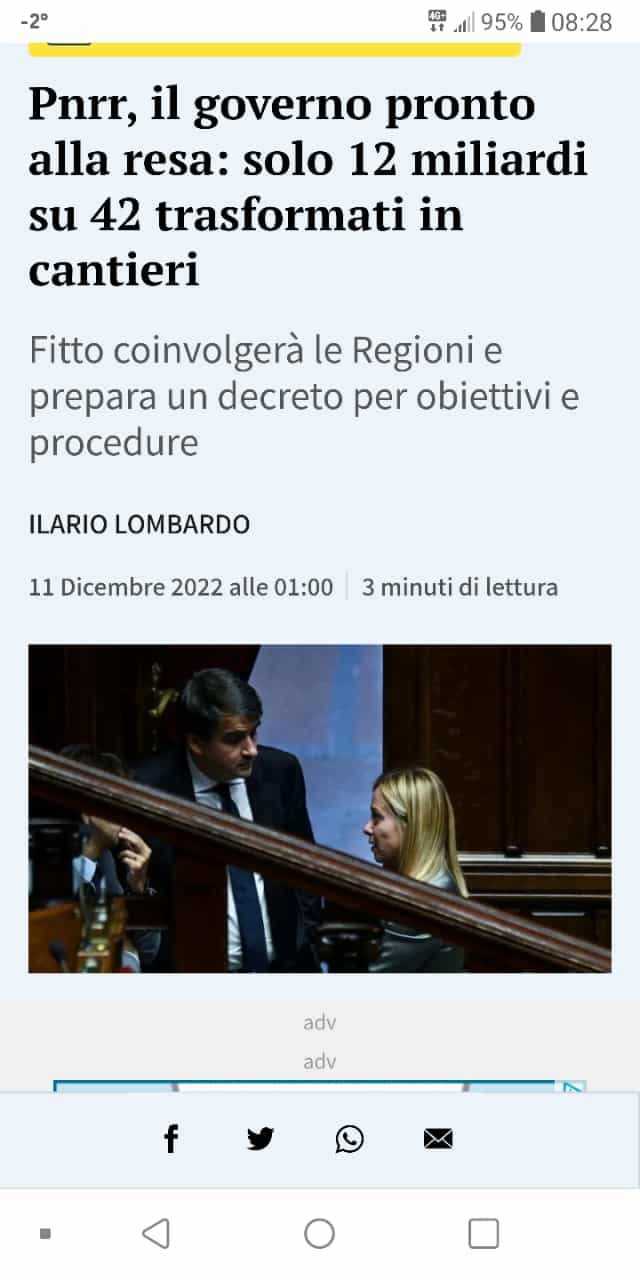
I am currently in Turin, that used to be a company town.
Which industry? Car making.
But, as described by others (including the book I quoted at the beginning), "making cars" is not just about cars.
Think systemically, but will start with an example that I already shared in the past, that I saw in a workshop in Brussels.
Most European Union countries in the 1950s abandoned the production of nuclear weapons (albeit Italy within the Treaty reserved the right to be part of a European nuke, check L'atomica europea. I progetti della guerra fredda, il ruolo dell'Italia, le domande del futuro), so they had the same issue that e.g. Italian companies had when they had, following a referendum, to abandon the nuclear energy industry.
In order to retain at least the "knowledge supply chain", Belgium developed its own laser capabilities, and the workshop I attended was to foster a similar conversion of the South African industry within an African Laser Center.
Italian companies within the (civilian) nuclear industry, to retain capabilities, recycled a few within the distribution.
Distribution does not seem too fancy- but, if you have multiple providers and sources, with different models and technical constraints, e.g. availability, requires something more complex to sustain a continued yet economical provision of energy, as we are all discovering after the invasion of Ukraine.
At the same time, to retain some more "hands-on" skills, there were investments and joint activities in other countries that still retained the civilian nuclear production capabilities.
If you look at the few phrases above, and try to visualize, you will already see a complex picture.
Moving back to producing cars.
Unless you are pre-paid by those willing to buy your car (something that for some came earlier, for many later, also if Tesla showed how you can make money just out of a willingness that will not turn into a purchase), manufacturing implies finance.
Also, manufacturing implies logistics to physically connect with your suppliers.
And, actually, when the local automaker was at its peak, its operational needs supported the expansion of other "ancillary" industries, that were actually useful to provide also for others.
I remember decades ago when any company that was growing asked banks the "tasso FIAT", i.e. the same interest rate paid by the local champion- and that was a benchmark for others.
Then, when I started my first project for my first official employer, software development in the 1980s, of course it was in... automotive procurement- so, coming from a political background, seeing the complexity from a European integration perspective, and then service in the Army where part of my role was helping organize travels to field exercises as well as distributing daily services, was able to see the complexity from an operational level (also because the first software was a vendor scoring system).
By the late 1980s, I was mostly working in other towns outside Piedmont, or even abroad, and therefore I knew of what was going on in my birthplace, Turin, via former colleagues and other assorted "antennas", who routinely shared the current status.
Not the trends, as, if you are inside a bubble, the natural attachment to the known, a kind of "cocooning", implies that most were looking for confirmation of their past, and at most raising alerts about micro-events that affected them directly.
The curious part: whenever those supporting free enterprise and cutting bureaucracy, ecc, in each of those micro-events, invoked... the intervention of public authorities.
Turin, in my view, unfortunately way too often, until was feasible, piled up debt and bad choices to generate a placebo effect: showing that they intervened, spending to show that they did something, to avoid the risk of making new choices.
Shift to 2002, when the Euro was in our pockets (and back then I was along those who said that we entered too high, but we had limited negotiating room), and Italy removed some of the "options" from the table.
I wrote "options" because, for a country with limited resources and whose industry was transforming raw materials or increasingly integrating with somebody else's supply chain, it was at best short-sighted to keep considering an industrial plan one based on routine devaluations.
While living in London and later, I remember that the up-and-downs of the GBP vs. the EUR eventually pushed at least a Japanese manufacturer to consider shifting production to France, despite the higher payroll costs, as having (as I had a month) a fluctuation of over 1/4 of the exchange rate, if you import in UK to manufacture and then re-export to Euroland to sell, was too cumbersome.
Anyway, when we entered the Euro, my perception from having lived (late 1990s) and worked (from late 1980s) abroad well before then was simply that we were already in decline.
Simply, we were used to tinkering our way out of the temporary issues, and leveraging on our "too big to fail" status in Europe.
The 2008 crisis therefore was layered on a pre-existing set of structural weaknesses (I will skip what shared already in the past, including when I was living in London and working in Paris and Zurich, or living in Brussels).
And the 2020 COVID impacts, as shown by the Recovery and Resilience Facility baseline KPIs, certified a continued "floating on issues".
The key additional element, as I shared in previous article? The discipline embedded within the #NextGenerationEU and its differential impacts are easily shown by the differential perception of risks within the European Union 27 Membser States business side.
Just to focus on France, Italy, Germany, joined both by bilateral treaties aiming to further integration, and industrial "weight":
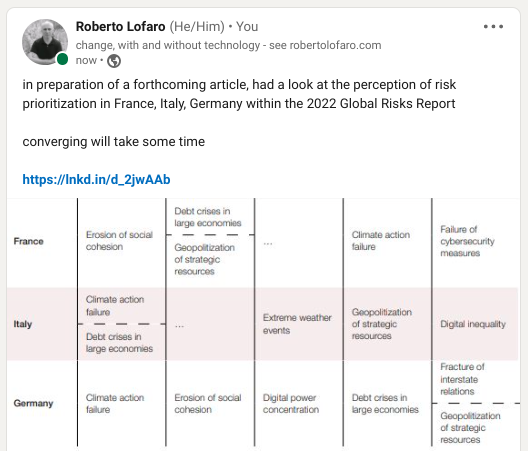
You can see within the dataset that I linked above details about other countries, but by late December plan to release on Kaggle a notebook that will allow to visualize and select combinations of factors.
Now, one of the aims of #NextGenerationEU was not just to recover to prior-COVID times, but to increase resilience for future issues, and accelerate convergence.
Convergence toward a shared model of "systemic" stability.
Hence, the conversion of Italy to a net receiver of funds (i.e. more than we will give back as a share of our contributions).
Something that still is elusive for many in Italy: the new status does not mean that those billions from Brussels are gifts- only that a tiny share of it is.
The balance? One way or the other, will have to return back.
Hence, the concept that the funds should be invested, not spent, so that they could generate flows to support both returning and that "convergence".
Quite funny that many my fellow Italians keep saying that is crazy whoever criticize their total lack of responsability toward those who will have to pay back.
But, as I wrote above, this "cocooning" had been in large part a key factor within the decades of decline.
So much that, few years ago, a political party was called "fermare il declino" (to halt- not to reverse- the decay).
I think that we need more dissenting voices, not less.
But, of course, that would not generate value for those involved- nobody, in the tribal socio-economic context of Italy, is praised for exposing her/his tribe to criticism by stating the obvious. Better to stick to the "common tribal consensus".
This week I am doing an update on the PNRR- by listening to voices, and reading data.
Because, in the end, the point is quite simple, as I saw since the 1980s in the business sector:
_ if you receive a budget and do not use it, as the rules were changed long ago in Brussels in no small measure for our inability to properly and in time allocate funds, you will lose them
_ if, as way too often we Italians did, do a "last minute run" to spend (not to invest) whatever is left, we risk generating more damages (not just reputational) than benefits.
As I shared above, the current Government said that we are on track with 12 billions of the 42 available for this year.
And today heard in a workshop presenting a report on finance at the regional level that actually getting even to 20 billions by year end would be a tough call.
One of the key reasons? While the past two governments did a lot of work to introduce changes, still, in preparing the National Recovery and Resilience Plan for Italy, the actually operational capabilities available where the implementation should be carried out were not fully considered or adequately expanded.
Which is, frankly, something that I was told already in 2005, while discussing a potential service to support mid-size Italian local authorities in having better access to resources from Brussels.
Let's see if the soon-to-be status check will allow a reconsideration not just of the current status, but also of the structural need to change.
As somebody else wrote long ago "question de mèthode".
 _
_